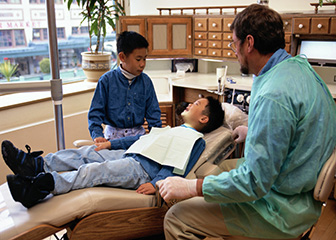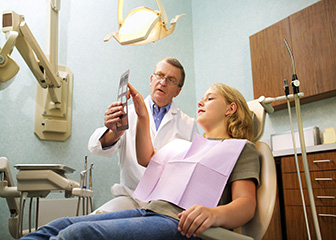
Dentists often work with patients of all ages.
Dentists must be licensed in all states; requirements vary by state. To qualify for a license in most states, applicants must graduate from an accredited dental school and pass written and practical exams.
Education and Training
High school students who want to become dentists should take courses in chemistry, physics, biology, anatomy, and mathematics.
Most dental students need at least a bachelor's degree before entering dental school; requirements vary by school. All dental schools require applicants to have completed certain required science courses, such as biology and chemistry. Majoring in a science, such as biology, might increase the chances of being accepted, but no specific major is required to enter most dental programs.
College undergraduates who plan on applying to dental school must usually take the Dental Acceptance Test (DAT) during their junior year. Admission to dental school can be competitive. Dental schools use these tests, along with other factors such as grade point average and recommendations, to admit students into their programs.
Dental schools require students to take classes such as local anesthesia, anatomy, periodontology (the study of oral disease and health), and radiology. All dental schools include practice where students work with patients in a clinical setting under the supervision of a licensed dentist.
All nine dental specialties require dentists to complete additional training before practicing that specialty. They must usually take a 1- or 2-year residency in a program related to their specialty.
Dentists who want to teach or research full time usually spend an additional 2 to 5 years in advanced dental training. Many practicing dentists also teach part time, including supervising students in dental school clinics. For more information, see the profile on postsecondary teachers.
Licenses
Dentists must be licensed in all states; requirements vary by state. In most states, a license requires a degree from an accredited dental school and passing a written and practical exam.
In addition, a dentist who wants to practice in one of the nine specialties that all states recognize must have a license in that specialty. This usually requires 2 to 4 years of additional education after dental school and, in some cases, the completion of a special state exam. A postgraduate residency term also may be required, usually lasting up to 2 years.
Important Qualities
Communication skills. Dentists must have excellent communication skills. They must be able to communicate effectively with patients, dental hygienists, dental assistants, and receptionists.
Detail oriented. Dentists must be detail oriented so patients receive appropriate treatments and medications. They must also pay attention to space, shape, and color. For example, they may need to closely match a false tooth with a patient’s other teeth.
Dexterity. Dentists must be good at working with their hands. They work with tools in a limited area.
Leadership skills. Most dentists work in their own practice. This requires them to manage and lead a staff.
Organizational skills. Strong organizational skills, including keeping accurate records of patient care, are critical in both medical and business settings.
Patience. Dentists may work for long periods of time with patients who need special attention. Children and patients with a fear of dental work may require a lot of patience.
Problem-solving skills. Dentists need strong problem-solving skills. They must evaluate patients’ symptoms and choose the appropriate treatments.
Stamina. Dentists should be comfortable performing physical tasks, such as bending over patients for long periods.









